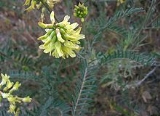
Astragalus trichopodus
Encyclopedia
Astragalus trichopodus is a species of legume
known by the common name Santa Barbara milk vetch. It is native to southern California
and Baja California
, where it grows in several types of open habitat, including in the Transverse Ranges
and Mojave Desert
.
This is a robust perennial herb producing a branching stem up to about a meter in maximum height. The hairy stem is lined with many leaves each up to 20 centimeters long which are made up of several pairs of widely-spaced lance-shaped leaflets each up to 2.5 centimeters in length. The inflorescence
is a raceme
of up to 50 flowers which are cream colored and sometimes tinted with light purple. Each flower is 2 or 3 centimeters long including its tubular base of sepal
s.
The fruit is a laterally compressed, slightly inflated legume pod up to 4 or 5 centimeters long which dries to a papery texture. The fruits hang in bunches where they develop from the inflorescence. Each pod contains many seeds.
Faboideae
Faboideae is a subfamily of the flowering plant family Fabaceae or Leguminosae. One acceptable alternative name for the subfamily is Papilionoideae....
known by the common name Santa Barbara milk vetch. It is native to southern California
California
California is a state located on the West Coast of the United States. It is by far the most populous U.S. state, and the third-largest by land area...
and Baja California
Baja California
Baja California officially Estado Libre y Soberano de Baja California is one of the 31 states which, with the Federal District, comprise the 32 Federal Entities of Mexico. It is both the northernmost and westernmost state of Mexico. Before becoming a state in 1953, the area was known as the North...
, where it grows in several types of open habitat, including in the Transverse Ranges
Transverse Ranges
The Transverse Ranges are a group of mountain ranges of southern California, in the Pacific Coast Ranges physiographic region that runs along the Pacific coast from Alaska to Mexico in North America. The Transverse Ranges begin at the southern end of the California Coast Ranges and lie between...
and Mojave Desert
Mojave Desert
The Mojave Desert occupies a significant portion of southeastern California and smaller parts of central California, southern Nevada, southwestern Utah and northwestern Arizona, in the United States...
.
This is a robust perennial herb producing a branching stem up to about a meter in maximum height. The hairy stem is lined with many leaves each up to 20 centimeters long which are made up of several pairs of widely-spaced lance-shaped leaflets each up to 2.5 centimeters in length. The inflorescence
Inflorescence
An inflorescence is a group or cluster of flowers arranged on a stem that is composed of a main branch or a complicated arrangement of branches. Strictly, it is the part of the shoot of seed plants where flowers are formed and which is accordingly modified...
is a raceme
Raceme
A raceme is a type of inflorescence that is unbranched and indeterminate and bears pedicellate flowers — flowers having short floral stalks called pedicels — along the axis. In botany, axis means a shoot, in this case one bearing the flowers. In a raceme, the oldest flowers are borne...
of up to 50 flowers which are cream colored and sometimes tinted with light purple. Each flower is 2 or 3 centimeters long including its tubular base of sepal
Sepal
A sepal is a part of the flower of angiosperms . Collectively the sepals form the calyx, which is the outermost whorl of parts that form a flower. Usually green, sepals have the typical function of protecting the petals when the flower is in bud...
s.
The fruit is a laterally compressed, slightly inflated legume pod up to 4 or 5 centimeters long which dries to a papery texture. The fruits hang in bunches where they develop from the inflorescence. Each pod contains many seeds.

